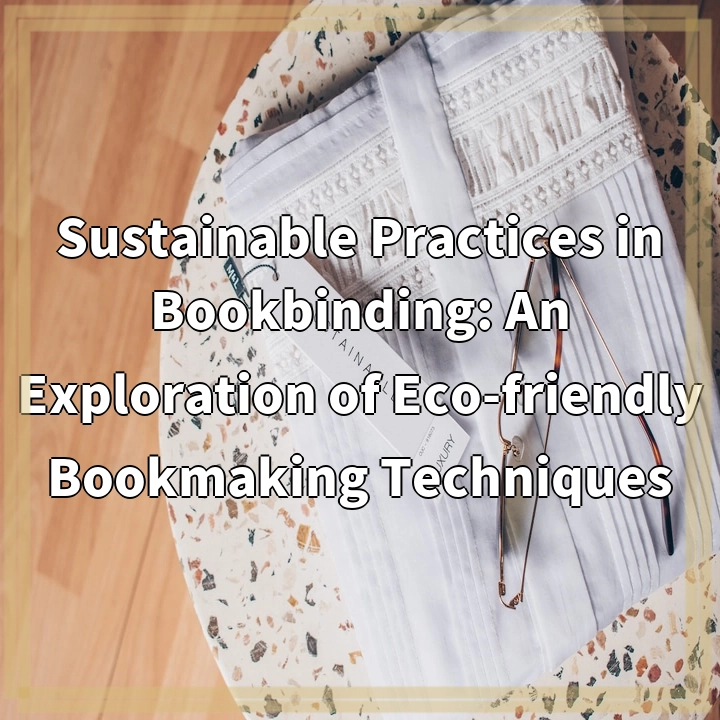
What it is:
Bookbinding is the craft of creating books, journals, and other bound materials. Sustainable practices in bookbinding involve utilizing eco-friendly techniques, materials, and processes to minimize the environmental impact of bookmaking.
One key aspect of sustainable bookbinding is the use of recycled and responsibly sourced materials. This includes using recycled paper for the pages and covers, as well as selecting binding materials made from renewable resources such as bamboo or hemp.
Another important aspect is reducing waste during the bookbinding process. This can be achieved through efficient cutting and trimming techniques, as well as finding creative ways to repurpose leftover materials.
Furthermore, sustainable bookbinding practices also involve using non-toxic adhesives, inks, and finishes, thus ensuring that harmful chemicals are not released into the environment during the production and use of books.
Real-World Problems:
Despite the growing awareness and adoption of sustainable bookbinding practices, there are still several real-world problems that need to be addressed.
One major challenge is the availability and affordability of eco-friendly materials. While recycled paper and sustainable binding materials are becoming more widely available, they can still be more expensive than conventional materials. This can pose a barrier for bookbinders on a tight budget or for small-scale bookbinding businesses.
Another issue is the lack of awareness and demand for sustainable books amongst consumers. Many readers may not prioritize eco-friendly materials when purchasing books or journals. This can discourage bookbinders from investing in sustainable practices and materials, as there may not be a significant market for such products.
Additionally, the traditional techniques and practices used in bookbinding are often deeply ingrained in the craft. This can make it challenging for bookbinders to shift towards eco-friendly alternatives, especially if they have limited access to training or resources on sustainable bookbinding techniques.
Lastly, the limited infrastructure for recycling and waste management in some regions can also pose challenges for bookbinders. Disposing of waste materials in an environmentally responsible way may be difficult if proper recycling facilities or programs are not readily available.
Addressing these real-world problems requires a collective effort from bookbinders, consumers, and industry stakeholders. Increased awareness, education, and support for sustainable practices are key to promoting a more eco-friendly approach to bookbinding.

Solutions to Sustainable Bookbinding:
1. Promote Accessible and Affordable Eco-friendly Materials:
The industry needs to work towards making sustainable bookbinding materials more readily available and affordable. Collaborations with suppliers and manufacturers can help increase the production and accessibility of recycled paper, responsibly sourced binding materials, and non-toxic adhesives. This will make it easier for bookbinders to adopt sustainable practices without the financial barrier.
2. Increase Consumer Awareness and Demand:
Educating consumers about the benefits and importance of sustainable bookbinding practices can help drive the demand for eco-friendly books and journals. Marketing campaigns, labels, and certifications can be used to highlight the environmental benefits of sustainable materials, attracting eco-conscious readers. This increased demand can incentivize bookbinders to prioritize sustainable practices and invest in eco-friendly alternatives.
3. Provide Training and Resources:
Offering training programs, workshops, and online resources on sustainable bookbinding techniques can help bookbinders transition from traditional methods to eco-friendly practices. By equipping them with the necessary knowledge and skills, they can confidently adopt sustainable techniques and contribute to reducing the environmental impact of bookbinding.
4. Support Recycling and Waste Management Initiatives:
Collaboration with recycling facilities and waste management programs is essential for proper disposal and management of bookbinding waste. Bookbinders can actively seek out recycling options for paper trimmings, leftover materials, and chemical waste. Supporting initiatives that promote recycling and waste reduction can contribute to a cleaner and more sustainable bookbinding industry.
By implementing these solutions, the bookbinding industry can make significant strides towards sustainability, promoting eco-friendly practices throughout the entire bookmaking process.















